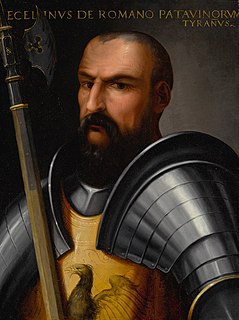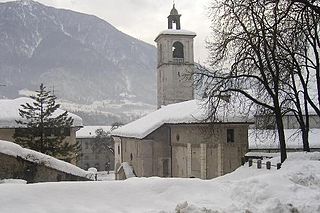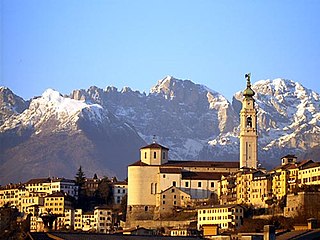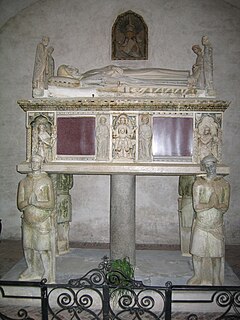
Zumelle Castle is a castle near the village of Tiago in the municipality of Borgo Valbelluna, province of Belluno, northern-eastern Italy.
Nearby the castle is the early medieval church of San Donato, of Lombard origins.

Zumelle Castle is a castle near the village of Tiago in the municipality of Borgo Valbelluna, province of Belluno, northern-eastern Italy.
Nearby the castle is the early medieval church of San Donato, of Lombard origins.
The first fortification on the site existed perhaps as early as c. 46–47 CE, when the Romans were consolidating their hold in the Valbelluna , conquered in the first century BCE. This fortification sat on a strategical location, commanding the road coming from the plain through the Praderadego, which has been identified as the Via Claudia Augusta Altinatis – or more likely, one of its side branches.
During and after the fall of the Western Roman Empire, the castle was the major stronghold of the area as it guarded the connections between Feltre and Ceneda. According to a legend, the ruined fortification was refounded by one Gaiseric (or Genseric), a faithful of queen Amalasuntha.[ citation needed ] After her assassination, he established a settlement here and had two twins (Italian: gemelle ), whence the name. During the early Middle Ages the castle was the location of a feudal struggle beginning in 737, when the Lombard king Liutprand appointed Valentino, bishop of Ceneda, as lord of Zumelle. This caused a controversy with John, count-bishop of Belluno, who already ruled these lands; the war ended in 750 after the intervention of the new king Aistulf. In 963, Emperor Otto I gave the county of Zumelle to the bishops of Belluno.
In 1037 emperor Conrad II assigned it to his baron Abelfred. The latter died with no male heirs, and the castle went to his daughter Adelheit, who married Wilfred of Colfosco. Their daughter Sofia in turn married Guecellone II da Camino, and thenceforth the castle was owned by the Caminesi family.
The castle was rebuilt in 1311 by Rizzardo IV da Camino, lord of Treviso, Belluno and Feltre, but after its conquest by the Republic of Venice it lost its importance. In 1501 it was sacked by imperial troops during the War of the League of Cambrai. Restored, it was subsequently owned by the Zorzi and Gritti families and, after the fall of the Venetian Republic, by the Austrian Empire. In 1872 it was acquired by the commune of Mel, which is still the current owner.
Coordinates: 46°2′10.50″N12°4′54″E / 46.0362500°N 12.08167°E

Ravenna is the capital city of the Province of Ravenna, in the Emilia-Romagna region of Northern Italy. It was the capital city of the Western Roman Empire from 408 during most period of its existence in the 5th century. It then served as the capital of the Ostrogothic Kingdom until it was re-conquered in 540 by the Byzantine Empire. Afterwards, the city formed the centre of the Byzantine Exarchate of Ravenna until the last exarch was executed by the Lombards in 751. Although it is an inland city, Ravenna is connected to the Adriatic Sea by the Candiano Canal. It is known for its well-preserved late Roman and Byzantine architecture, with eight buildings comprising the UNESCO World Heritage Site "Early Christian Monuments of Ravenna".

Monza is a city and comune on the River Lambro, a tributary of the Po in the Lombardy region of Italy, about 20 kilometres north-northeast of Milan. It is the capital of the Province of Monza and Brianza. Monza is best known for its Grand Prix motor racing circuit, the Autodromo Nazionale di Monza, which hosts the Formula One Italian Grand Prix with a massive Italian support tifosi for the Ferrari team.

Vittorio Veneto is a city and comune situated in the Province of Treviso, in the region of Veneto, Italy, in the northeast of Italy, between the Piave and the Livenza rivers, borders with the following municipalities:

Ezzelino III da Romano was an Italian feudal lord, a member of the Ezzelino family, in the March of Treviso. He was a close ally of the emperor Frederick II, and ruled Verona, Vicenza and Padua for almost two decades. He became infamous as a cruel tyrant, and was, in fact, the most "notorious" of the "early tyrants".

Feltre is a town and comune of the province of Belluno in Veneto, northern Italy. A hill town in the southern reaches of the province, it is located on the Stizzon River, about 4 kilometres from its junction with the Piave, and 20 km (12 mi) southwest from Belluno. The Dolomites loom to the north of the town.

Belluno is a town and province in the Veneto region of northern Italy. Located about 100 kilometres north of Venice, Belluno is the capital of the province of Belluno and the most important city in the Eastern Dolomites region. With its roughly 36,000 inhabitants, it is the largest populated area of Valbelluna. It is one of the 15 municipalities of the Dolomiti Bellunesi National Park.

The Patriarchate of Aquileia was an episcopal see in northeastern Italy, centred on the ancient city of Aquileia situated at the head of the Adriatic, on what is now the Italian seacoast. For many centuries it played an important part in history, particularly in that of the Holy See and northern Italy, and a number of church councils were held there.

Oderzo is a comune with a population of 20,003 in the province of Treviso, Veneto, northern Italy. It lies in the heart of the Venetian plain, about 66 kilometres to the northeast of Venice. Oderzo is crossed by the Monticano River, a tributary of the Livenza.

Mel was a comune (municipality) in the province of Belluno in the Italian region of Veneto, located about 170 kilometres north of Venice and about 14 kilometres southwest of Belluno and about 16 kilometres northeast of Feltre.

The Diocese of Vittorio Veneto is a Roman Catholic diocese in northern Italy, with capital in Vittorio Veneto. It was historically known as Diocese of Ceneda, the name being changed in 1939.

The Diocese of Belluno-Feltre is a Roman Catholic ecclesiastical territory in the Veneto, northern Italy, organized in its current form in 1986. From 1197 to 1762, and again from 1818 to 1986, the Diocese of Belluno and the Diocese of Feltre were united under a single bishop, with the name diocese of Belluno e Feltre. The current diocese is a suffragan of the Patriarchate of Venice.
Gherardo III da Camino was an Italian feudal lord and military leader. He is generally considered the most outstanding member in the da Camino family.

The da Camino were an Italian noble family whose fame is connected to the mediaeval history of the March of Treviso, a city of which they were lords for a while.

Francesco I da Carrara, called il Vecchio, was Lord of Padua from 1350 to 1388.
Guecellone II da Camino was an Italian medieval noble and military leader, belonging to the Da Camino family.
Biaquino II da Camino was an Italian nobleman and military leader, a member of the da Camino family and lord of Treviso.
Tolberto III da Camino (1263–1317) was an Italian nobleman and military leader, a member of the Da Camino family.
Guecellone VII da Camino was an Italian nobleman and lord of Treviso.
The Italian Catholic diocese of Feltre, in the Veneto existed from 1462 to 1818. It was then united into the diocese of Belluno e Feltre. It had previously had an independent existence, up to 1197.
Giordano Forzatè, anglicized Jordan Forzatè, was a Paduan Benedictine monk and religious leader. For his noble background, peacemaking efforts and monastic reforms, the Chronicle of the Trevisan March calls him the pater Padue, "father of Padua".